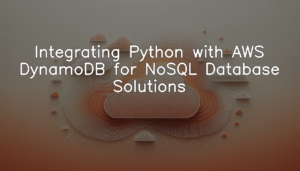5 ways Python can Automate Digital Marketing
Python is becoming an increasingly popular tool in the digital marketing world. Its flexibility and wide range of applications make it ideal for a variety of tasks, from automation to data analysis. Skip the tedious excel spreadsheet work and daily reminders to update your database and let Python manage your data for you.
But first, what exactly is Python?
Python is a versatile programming language that has become increasingly popular in the world of data science and automation. It is widely used by developers, engineers, and marketers to develop software applications, create websites, and automate tasks. With its simple syntax structure, Python can be used for many different purposes such as creating scripts for web applications or automating marketing pipelines.
Python offers powerful open-source libraries with built-in functions that are easy to use and can help marketers build automated campaigns quickly without having to learn complex algorithms or code from scratch. Additionally, Python’s large user base makes it easier to find helpful resources online when troubleshooting coding challenges. With its many capabilities and user-friendly interface, Python is an excellent choice for automating marketing processes without spending too much time on development.
Furthermore, its data wrangling capabilities make it useful for cleaning up datasets and preparing them for further analysis. Python also has many powerful libraries for data analysis and visualization, such as Numpy, Matplotlib, Pandas, and Scikit-learn. These libraries allow users to easily manipulate, analyze, and visualize data.
Python is a great choice for scientists, researchers, and engineers who need to quickly develop sophisticated data science solutions. It is also ideal for people who need to develop scripts that automate routine tasks or generate reports from large datasets. Python’s flexibility and ease of use make it an excellent choice for data science projects of any size.
So, how can marketers use Python to make their lives easier?
Automate Daily Tasks
Python can be used to develop custom software solutions tailored to specific marketing objectives. This could include automating repetitive manual tasks, creating custom visualizations and analytics, or developing novel algorithms for identifying customer trends. Moreover, Python is well-suited for web development; its powerful frameworks make it easy to create web-based applications that can analyze user behavior and track performance metrics. With its intuitive syntax and user-friendly libraries, marketers can easily create custom programs for their business needs without having a deep understanding of coding or mathematics. The possibilities are virtually limitless when it comes to automating your marketing pipeline using Python!
SEO Efforts
Python can also be used to help with search engine optimization (SEO) efforts such as crawling websites for keyword analysis and backlink analysis, creating keyword maps, and tracking the performance of SEO campaigns. Additionally, Python can be used to automate mundane tasks such as submitting website pages to search engines or generating reports from analytics data. Finally, Python can be used to develop custom web applications which may be useful for SEO purposes such as providing user-generated content or creating a blog platform for SEO campaigns.
Leverage Machine Learning
Machine learning algorithms can be utilized and deployed with Python to identify new opportunities in the marketplace or automate decision-making processes. For example, supervised learning algorithms such as linear regression, decision trees, and support vector machines can be used to predict customer demand and identify new markets. Unsupervised learning algorithms such as clustering, segmentation, and association rule mining can be used to discover hidden patterns in data. Neural networks can be used to generate new features from existing data or to build predictive models for forecasting customer behavior. Additionally, natural language processing (NLP) libraries enable text mining which can help uncover insights from large amounts of textual data such as customer reviews or social media conversations.
Powerful Visualization
Python’s powerful visualization libraries make it easy to create engaging visualizations of complex data sets that can guide decision making processes or inform campaigns. The most popular Python visualization libraries include Matplotlib, Seaborn, Plotly, and Bokeh. These libraries can be used to create a wide range of different types of visualizations such as scatter plots, line graphs, histograms, heatmaps, and more. Each library offers unique features that make it better suited for certain types of data or particular use cases. For example, Matplotlib is very versatile and is frequently used for basic data visualization tasks while Plotly is ideal for creating interactive visualizations that can be embedded in websites or shared online. Similarly, Seaborn is great for quickly creating high-quality statistical plots while Bokeh is designed specifically for building interactive web-based visualizations.
No matter which library you choose to use, the key to successful data visualization with Python lies in understanding the basics of data science principles and the capabilities of each library. With a bit of practice and experimentation you can easily become an expert at using Python’s powerful visualization libraries to create stunning visuals from complex datasets.
Data Pipeline Automation
Application Program Interfaces (APIs) are easily accessible via Python which enables marketers to integrate third-party services into existing platforms and pull valuable data from different sources into a single dashboard view. This can help marketers to understand customer behaviors, track competitor activities, and improve their marketing campaigns. Python also enables marketers to automate tasks such as collecting data from various sources and organizing it in a way that makes sense for their business. Additionally, Python can be used to create customized dashboards or reports that provide an at-a-glance overview of key performance indicators. Lastly, with automated testing libraries like Selenium, marketers can test their digital experiences across multiple devices quickly and easily. By simulating user interactions, marketers can ensure their users have a consistent and enjoyable experience regardless of the device they use. Automated testing allows marketers to save time by quickly pinpointing potential issues, rather than having to manually test every single device.
Benefits: Unlocking Python Automation
The automation of marketing pipelines has become increasingly popular in recent years, with many businesses turning to Python as the language of choice. Now that we have explored five ways to automate your marketing pipeline using Python, it’s time to look at the benefits that result from automating complex processes.
One key benefit of marketing automation is efficiency – automating a process can reduce human error and enable faster completion times. Automation can also reduce costs, as manual labor or specific software programs may no longer be necessary for certain tasks. Additionally, automated processes provide more accurate data tracking and analysis which can lead to better decisions about strategy and campaigns.
Ultimately, automation offers organizations the ability to streamline operations and increase productivity resulting in improved ROI. By unlocking the potential of automation through programming languages like Python, marketers are able to take advantage of these tools for improved performance and success.
In conclusion, Python has a lot of potential uses in digital marketing which makes it an invaluable tool for any marketer looking to take their strategies to the next level. Data utilization and optimization has never been easier.





